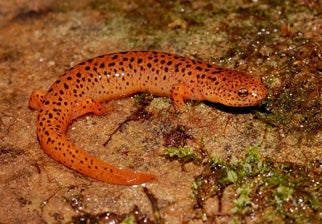SCIENTIFIC NAME:
Pseudotriton ruber ruber
OTHER NAMES:
Along with other aquatic salamanders, this species is commonly called “spring lizard” by many, due to its association with spring-fed pools.
STATUS:
Fairly common above Fall Line Hills. Intergrades with southern red salamander in upper portions of Coastal Plain. Low Conservation Concern.
DESCRIPTION:
This large, stout salamander reaches a maximum total length of 18 cm. The back is a bright orange-red color with numerous bold black spots; underside is usually pink and unmarked. With age, individuals turn purplish and spots enlarge, becoming less defined. This species is often confused with the Mud Salamander (Pseudotriton montanus), as these species look similar and co-exist throughout much of their ranges. However, Red Salamanders generally differ in having more spots, golden irises, and a dark horizontal bar through the eye. Larval Red Salamanders tend to have less pronounced gills than larval Mud Salamanders.
DISTRIBUTION:
New York south through Appalachia to the Florida panhandle and Mississippi. Unlike the Mud Salamander, Red Salamanders occur at high elevations throughout Appalachia. In Alabama, this form occurs in the north-eastern portion of the state. Throughout central and western Alabama, the Northern and Southern Red Salamanders intergrade, appearing morphologically intermediate. This species is common in the aforementioned areas.
HABITAT:
Often found near spring-fed pools and small streams in forested areas underneath logs, rocks, and leaf-litter. Occasionally, individuals will travel away from water sources and be found underneath cover objects in relatively dry habitats. This species is fossorial, often occupying tunnel systems in the vicinity of the preferred wetland habitats. Juveniles (larvae) live in slow-moving springs, seepages, or floodplain ponds.
FEEDING HABITS:
Adults are known to consume a wide variety of invertebrates and other salamanders (e.g., Eurycea, Desmognathus, Plethodon, etc.), while larvae eat aquatic invertebrates and other salamander larvae.
LIFE HISTORY AND ECOLOGY:
Eggs are laid singly beneath rocks or other structures in springs, head-water streams, and seeps. Some evidence suggests that clutches may range from 29 – 130 eggs. Female Red Salamanders are known to attend eggs sites, probably to protect them from predators.
After hatching in late autumn and winter, individuals usually have an aquatic larval period of 27 - 31 months. Larvae live within the leaf-litter of their aquatic habitats, breathing through gills. Often these pools will dry up during warm summer months; larvae presumably recede to underground cavities when this occurs. Upon reaching a suitable size (6 – 9 cm), larvae stop feeding, absorb their gills, and metamorphose to the adult form. Red Salamander larvae grow more slowly than the closely related Mud Salamander larvae.
In the fall, adult Red Salamanders concentrate in springs or streams, eventually overwintering in these aquatic sites. Some evidence suggests that males outnumber females as adults, and male competition for mates may be stiff. Adults are known to be sexually dimorphic: females tend to be longer than males. Red Salamanders are known to be preyed upon by birds, mammals, and snakes.
REFERENCES:
Bruce, R.C. 1974. Larval Development of the Salamanders Pseudotriton montanus and P. ruber. American Midland Naturalist 92: 173-190.
Miller, B.T., M.L Niemiller, and R.G. Reynolds. 2008. Observation on Egg-laying Behavior and Interactions Among Attending Female Red Salamanders (Pseudotriton ruber) with Comments on the Use of Caves by This Species. Herpetological Conservation and Biology 3: 203-210.
Mount, R. 1975. The Reptiles & Amphibians of Alabama. Auburn Printing Co., Auburn, AL.
Petranka, J.W. 1998. Salamanders of the United States and Canada. Smithsonian Institution Press.
AUTHOR: Brian P. Folt, Ph.D. Student, Auburn University






